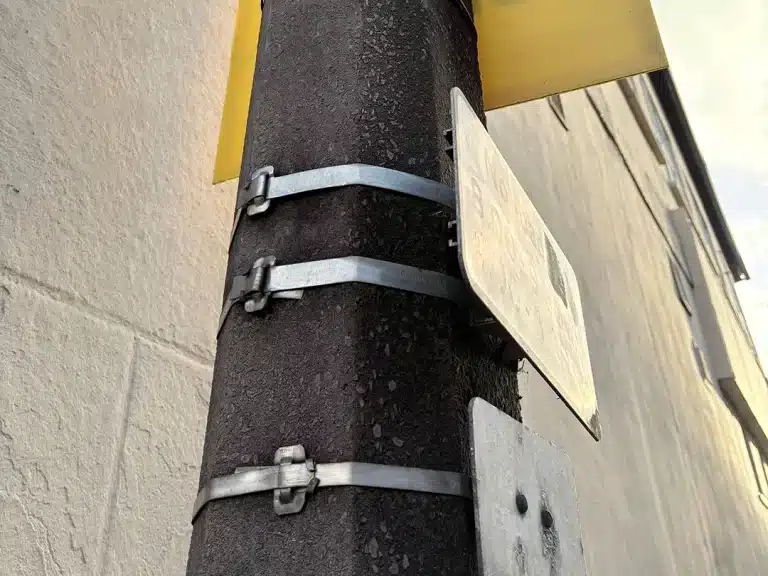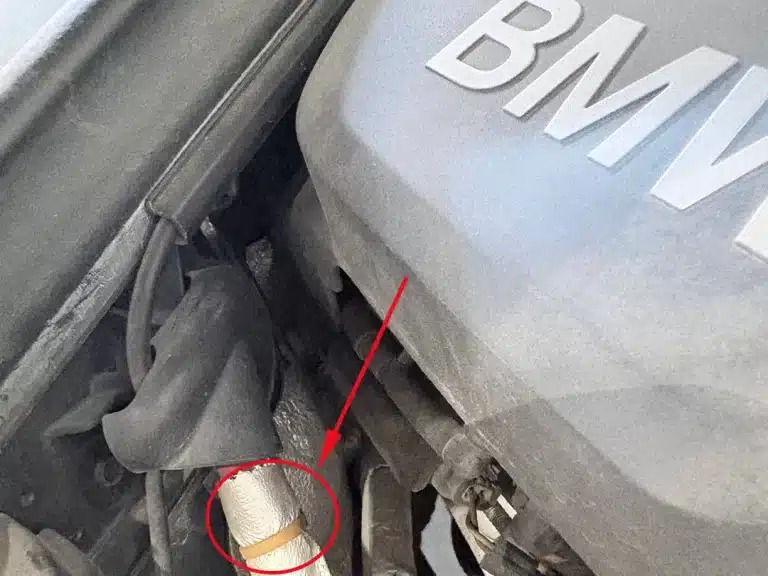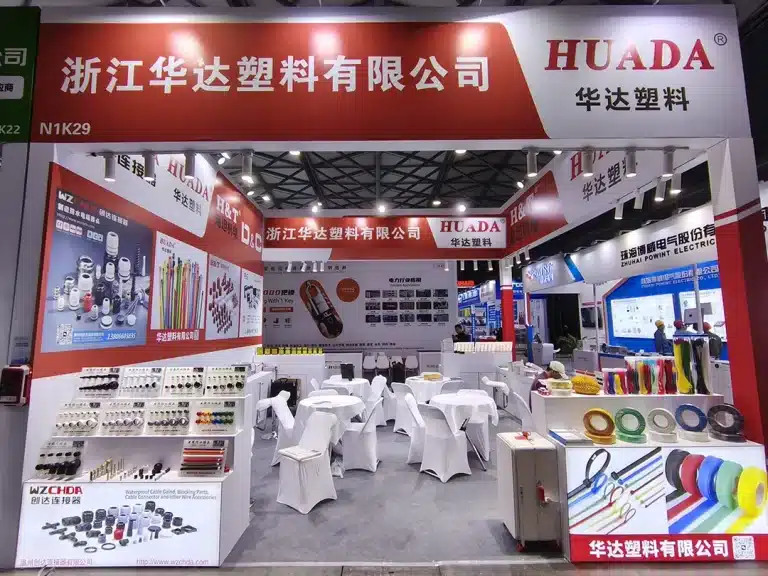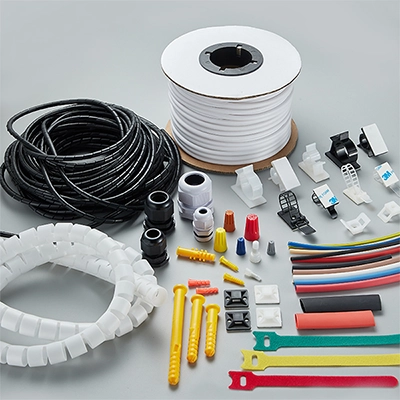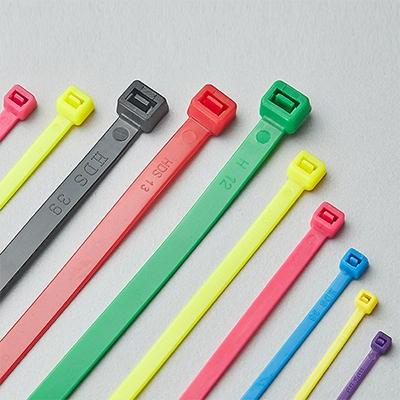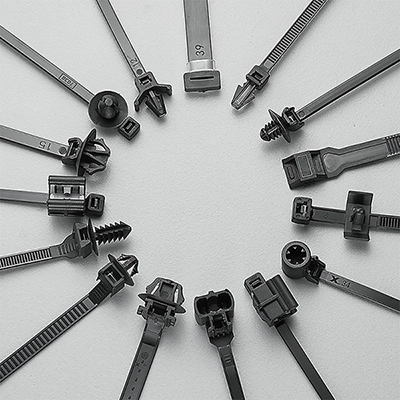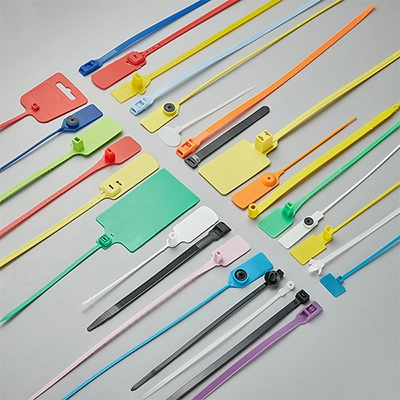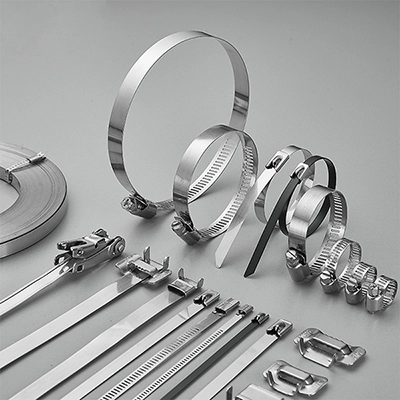As temperatures drop, the need for cold weather zip ties increases. Regular cable ties often become stiff and brittle in the colder months, leading to breakage. This is especially true when working outdoors, installing surveillance systems, or in construction projects in colder climates. Regular zip ties, which are usually flexible, can turn brittle like a cookie, snapping with just a little pull.
In this article, we’ll compare the differences between regular and cold weather cable ties from three key perspectives: material, temperature, and typical usage. We’ll also help you choose the right tie for the harsh winter conditions.
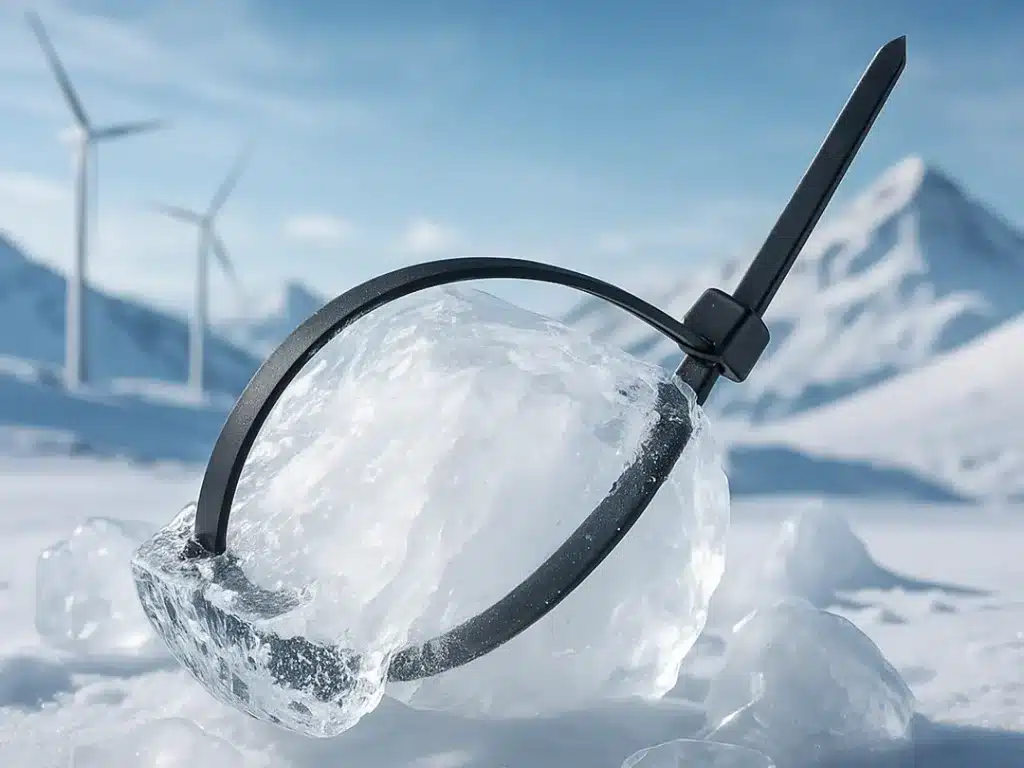
1. Why Switch to Cold Weather Zip Ties in Winter?
The performance of cable ties changes with temperature. While regular nylon ties have good tensile strength and flexibility at normal temperatures, their molecular activity decreases as the temperature drops, causing the material to become stiff. Generally, when the temperature drops to around -15°C, the impact resistance of nylon significantly reduces, making it more prone to breaking under stress.
For outdoor environments in northern China during the winter, low temperatures, dryness, and the tension during construction make regular zip ties more likely to fail.
That’s why, as winter approaches, it’s recommended to switch to cold weather zip ties. These ties are also made from PA66 nylon, but they undergo a special low-temperature modification during manufacturing. This treatment ensures that the molecular structure retains some flexibility even in cold environments, preserving the tie’s strength and toughness.
Cold weather cable ties can continue to perform reliably in environments as cold as -20°C or -30°C, without becoming brittle like regular zip ties.
For outdoor projects that require long-term fastening or work in extremely cold regions such as northern China, cold weather zip ties are an effective way to reduce breakage rates and minimize the risk of rework caused by temperature fluctuations.
2. What’s The Difference Between Regular and Cold Weather Zip Ties
Visually, regular cable ties and cold weather zip ties from the same cable tie manufacturer may look almost identical. However, the difference becomes very apparent when it comes to feel and performance. Regular cable ties feel firmer and stiffer, while cold weather cable ties are slightly more flexible, offering more stretch when bent.
This difference comes from the adjustments made in the material formulation. To ensure cold weather zip ties maintain their toughness in low temperatures, the product usually sacrifices some tensile strength. As a result, regular PA66 cable ties tend to have a slightly higher tensile strength, while cold weather zip ties excel in low-temperature adaptability.
This difference becomes even more noticeable in actual use. In cold weather, regular cable ties become stiff, and when passing through the locking mechanism, the teeth produce a rough, crisp “clicking” sound. In contrast, cold weather zip ties remain smooth at the same temperature, with a softer and more continuous sound when tightened, and are less likely to experience issues like teeth jamming or the locking mechanism breaking. For workers who need to tie things repeatedly in cold conditions, this difference is much more pronounced.
Additionally, there is a price difference between the two types. Due to the material adjustments, cold weather zip ties are slightly more expensive than regular PA66 cable ties. However, from a long-term usage perspective, especially in winter or cold-region construction, cold weather cable ties effectively reduce the risk of breakage and rework. The labor cost savings often far outweigh the material price difference. In high-quality or critical projects, buyers often prioritize cold weather cable ties to ensure safety and stability in low-temperature environments.
3. Which Environments Are Best Suited for Cold Weather Zip Ties?
Cold Weather Zip Ties are not required in every scenario, but in low temperatures or environments with significant temperature fluctuations, their advantages become clear. The most typical applications can be grouped into three categories:
Outdoor Construction Sites in Northern China Winters
Many cities have power, telecommunications, and municipal projects that continue working in sub-zero temperatures. Regular zip ties tend to stiffen and crack in such environments, resulting in frequent breakage and decreased efficiency. Cold Weather Zip Ties, on the other hand, significantly improve this situation, maintaining strong tensile strength and flexibility even in temperatures as low as -20°C or -30°C.
Cold Storage and Cold Chain Transportation
Cold storage facilities often maintain temperatures well below freezing, sometimes as low as -10°C. In such environments, regular zip ties become brittle over time, and they may break during door opening or from vibrations. Cold Weather Zip Ties perform much better in these conditions, providing better durability and reliability to maintain secure fastening over the long term.
Export Projects to Cold or Extremely Dry Regions
Projects heading to regions with cold climates or extreme dryness — such as Russia, Mongolia, the Nordic countries, and high-altitude areas of the Middle East — also benefit from Cold Weather Zip Ties. Dry, cold climates accelerate the loss of moisture in nylon, causing it to become brittle. Even when temperatures are not extremely low, materials can crack under strain during construction or long-term use. Cold Weather Zip Ties maintain stable mechanical properties in these environments, offering longer service life.
In general, if the working environment has temperatures consistently below -15°C, large day-to-night temperature fluctuations, or extreme dryness, Cold Weather Zip Ties are the most reliable and worry-free choice.
4. Conclusion
As one of the most common industrial accessories, the performance of cable ties often determines whether the fastening is secure. Regular PA66 ties or PA6 ties are durable enough in normal temperature environments and are the go-to choice for most projects. However, in winter or low-temperature working conditions, cold weather zip ties offer a better balance of flexibility and strength, preventing the ties from becoming brittle and snapping.
For many construction sites and engineering projects, choosing the right type of cable tie based on the season is more important than simply opting for one standard model. In summer, UV-resistant ties should be chosen, while in winter, cold weather zip ties are ideal. Using the right material for the right environment not only extends the lifespan of the ties but also makes construction easier and more reliable. This “seasonal selection” approach is often the most economical and dependable method. For more guidance, check out our article on the Latest Cable Ties Selection Guide.
Of course, even modified PA66 has its temperature limits. In more extreme conditions, such as areas with temperatures below -40°C or locations exposed to snow and wind for long periods, consider using PA12 cable ties or stainless steel cable ties. The former offers better flexibility, while the latter is almost unaffected by temperature.
Whatever material you choose, the key is to match the right tie to the environment. Especially for high-quality projects, selecting the right type at the outset can make the entire construction process more stable and efficient.
FAQ: 5 Common Questions About Cold Weather Zip Ties
Q1: Are Cold Weather Zip Ties made of PA66?
Yes. Cold weather zip ties are made from PA66 nylon, which is then modified through a special low-temperature treatment. This modification allows the molecular structure to retain flexibility and toughness even in cold environments.
Q2: Do Cold Weather Zip Ties have lower tensile strength than regular zip ties?
Generally, yes. For the same size, regular PA66 nylon cable ties have slightly higher tensile strength. Cold weather zip ties, while designed to maintain flexibility in low temperatures, sacrifice a small amount of tensile strength. However, the difference is minimal, and they can still be used effectively.
Q3: Are Low Temperature Zip Ties the same as Cold Weather Zip Ties?
Yes. Both terms refer to the same type of product, though manufacturers may sometimes refer to them as “frost-resistant zip ties.”
Q4: Can Cold Weather Zip Ties be used in summer?
Yes. Cold weather zip ties remain stable at normal temperatures, so they won’t soften or deform in warmer conditions. The only downside is that they may cost slightly more than regular zip ties.
Q5: Do I need to mention cold climates or high-altitude areas when exporting?
It’s recommended. In regions with dry, cold climates or large temperature fluctuations — such as Russia, Mongolia, Northern Europe, Central Asia, or the highlands of the Middle East — regular zip ties can become brittle due to moisture loss. It’s a good idea to inform your cable tie manufacturer about the specific environment so they can provide the most suitable recommendations.
